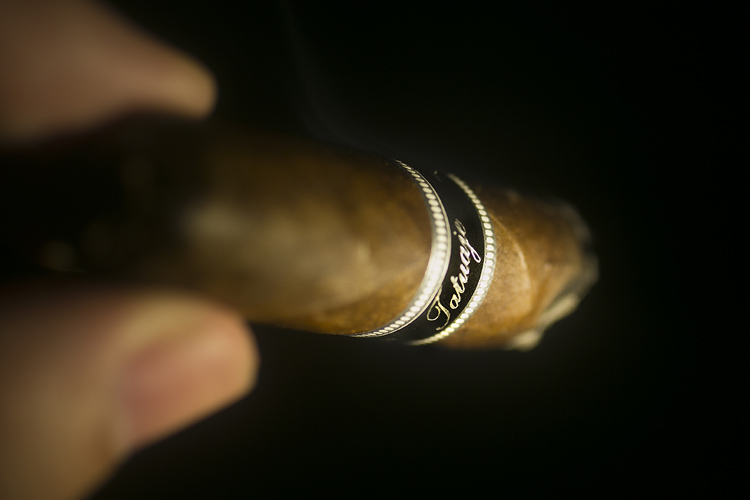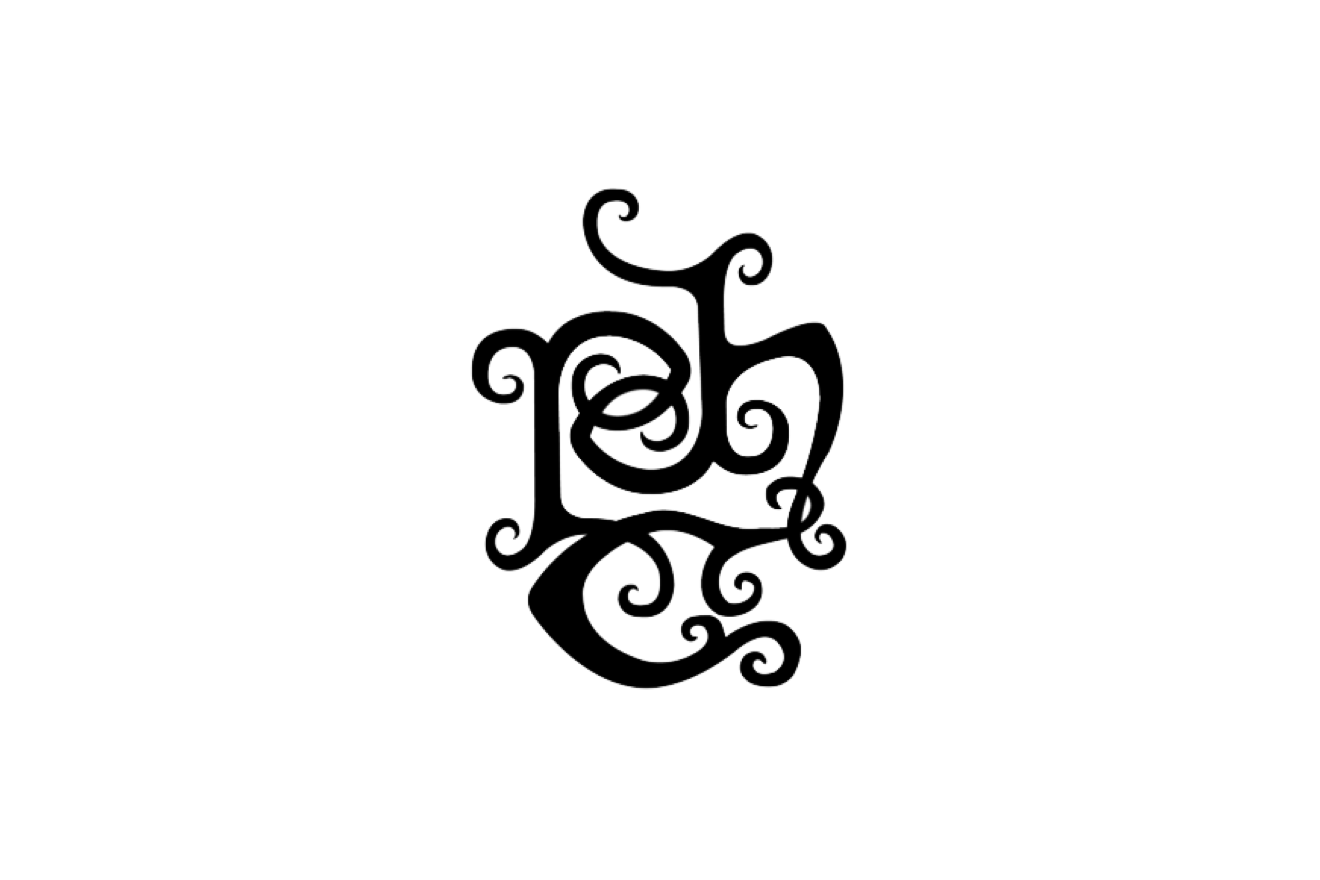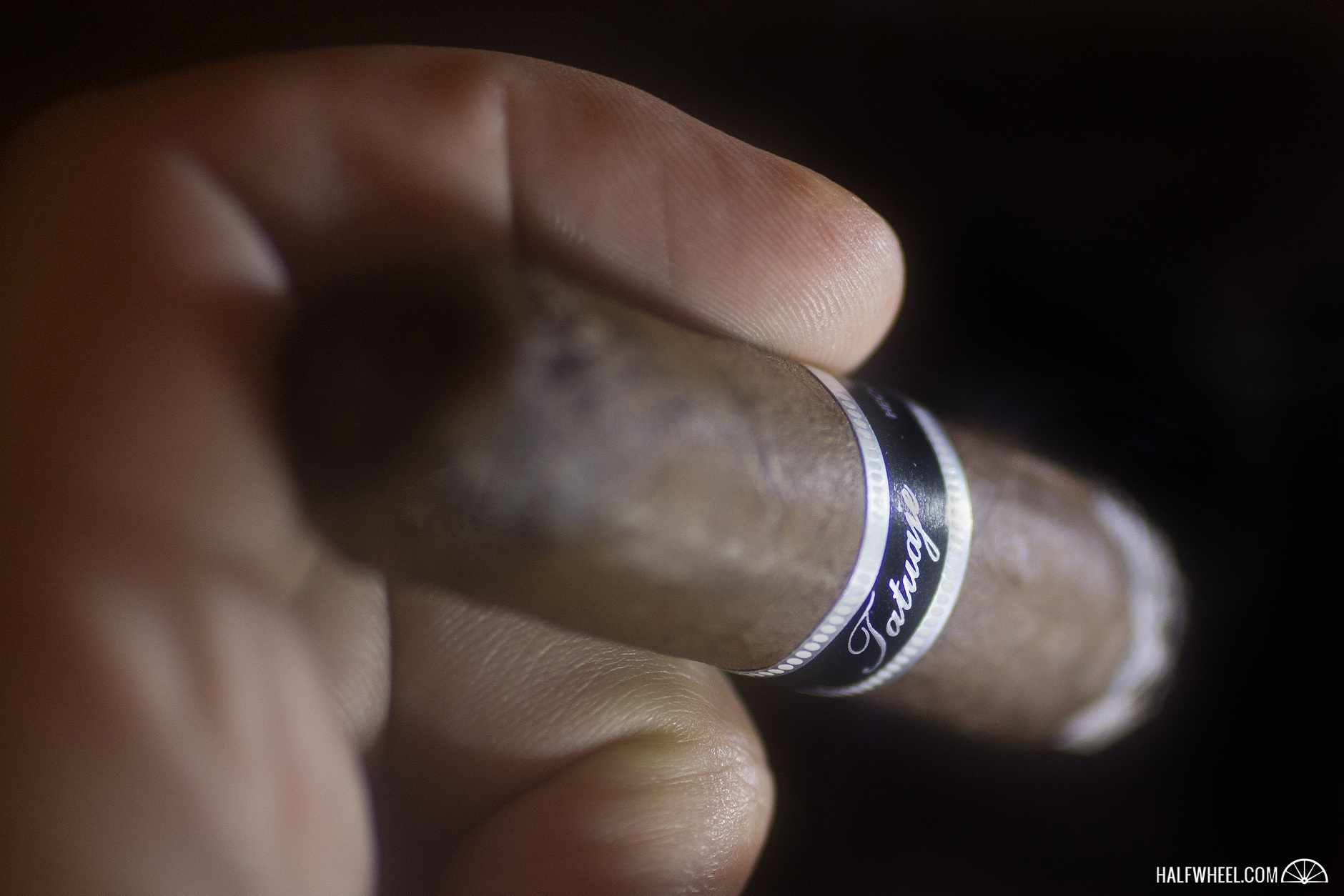You can have a debate about what the best Tatuaje is of all-time, but there is no question about which is the most memorable Tatuaje release. It debuted in 2007, it came in jars of 19—although some times in bundles—and for the last six years Tatuaje founder Pete Johnson has inevitably been asked thousands of times regarding its return. It is the Tatuaje Black Label Corona Gorda.
About two years ago, Johnson began publicly discussing his plans for his 10th anniversary—a milestone he celebrates this year—amongst which included the re-release of the Corona Gorda, in jars. At this point, it appears the Tatuaje Black Label Corona Gorda 2013 will be the final of these commemorative releases, which have included re-released Cohete, Noella Reserva, Regio Reserva; commemorative versions of the original Brown Label vitolas; two new sizes of Brown Label and the TAA 2013, which is also a Brown Label release.
The original Corona Gorda debuted in 2007, the first of the Tatuaje Private Reserve line, which is much better known as Black Label. At that time, the cigar was limited to 25-count—and later 24-count—bundles, but the following year, Johnson released the cigar in 1,000 jars of 19 cigars. It became the most sought-after Tatuaje cigar with prices of full jars peaking at north of $1,000.00 and empty jars themselves running $200.00.
After watching dozens of his limited cigars see their selling prices double and triple on the secondary market upon selling out on retail shelves, Johnson is acutely aware—perhaps more than anyone in the industry—of the supply-and-demand amongst collectors. He’s also heard—on countless occasions—about the difficulties in finding some of his limited releases and then of the prices being asked.
In 2010, with the release of the third Monster Series—The Face—Johnson made a stand. He decided to release 666 collector’s coffins of the cigar—as he did with both of the previous releases—but then also released 1,300 plain boxes. Johnson has always described the move, at its core, as one that allowed people who just wanted to smoke the cigar an opportunity to buy the cigar at retail price without having to jump through hoops. Last year, he took this a step further with the Little Monsters, a release he consistently characterized as large enough so that the cigars would be in stores for a while.
The same strategy is being employed with the Black Label Corona Gorda 2013.
This month Johnson will begin shipping 500 bundles of 19 cigars to retailers that specifically requested the bundles, in an effort to get the cigars early. At a later date—currently described as sometime between Black Friday (November 29) and Christmas—the jars will begin shipping. There are 10,000 jars, also of 19 cigars, with the intent once again to have the cigars on retailer shelves for a prolonged period of time.
The releases carry an identical price, $10.00 per cigar or $190.00 per bundle/jar.
For those unfamiliar with the mystique surrounding the Black Label Corona Gorda, there are a plethora of factors. First and foremost, it was generally received as a superior cigar. Secondly, it was Johnson’s personal cigar. Finally—and perhaps most importantly—they were limited. As such, for years following the release, the jar as it became known carried weight amongst the Tatuaje fans that was unmatched. Prices skyrocketed and the online lure surrounding the cigar grew as well. Even by the time Brooks Whittington reviewed the cigar here at halfwheel late last year, there was little evidence online that this was not the best cigar Tatuaje had ever produced. The reality six years later was that the cigar was still good, but an obvious shadow of itself.
Johnson described the story behind the cigar a few years ago:
On a recent trip to a famous island known for historic cigar making, I spent my time in a small town enjoying the simple life. Every day was peaceful and every night was festive, with both having cigars involved throughout. My favorite cigar was not a cigar bought at the local store or factory, but a cigar that was handed to me every morning.
Mornings, after taking a shower with a bucket of water warmed with what looked like a curling iron, I would walk to the front of the house and sit on the fence to get some sun and take in the fresh air. I also took in the fact that I was miles from home and no one knew where I was. My phone didn’t work and I had no cares in the world other than trying to decide what to smoke.
My first morning on the island an older gentleman came along on his bike. This was not a motorcycle but something like an old Schwinn that he had likely been riding for decades. This gentleman was well dressed, almost dapper, and I probably appeared to him to be a strange character. My usual outfit of jeans, t-shirt, loads of silver jewelry, and an arm full of tattoos didn’t seem to faze him. He saw I was enjoying myself so that morning, and every morning after that, he would stop and give me a cigar from his shirt pocket.
This cigar was far from being a ‘pretty’ cigar but that did not bother me a bit. It was a treasured and unexpected gift that I was thrilled to be given. After smoking this cigar I realized that this was one of the best cigars I smoked on the island. Later that day in speaking with my host on this trip I came to understand that these cigars were something special to every person who carried them. They were cigars that they made for themselves. Even the guys who worked hard in the cigar factories all day would return home at night and make their private cigars. Simple cigars with flavors they personally enjoyed. Over the course of the next few days my host and I visited his friends and asked for cigars that they made. Before I left I had cigars from a few locals who all used different tobaccos from the different growing regions. They were all great but there was one that really stood out for me as special.
I decided when traveling to Nicaragua to work with the Garcia family that I would try to recreate this special cigar for myself. Together we spent quite some time working on the blend and looking at different leaves for wrapper. The marbled toothy wrapper was perfect for this cigar, rustic looking but with tons of aroma. After smoking the first sample, I was immediately brought back to that island relaxing on a fence, enjoying life, smoking a great cigar. A great cigar that will always in my mind represent the place, the time, and the experience of the purity of the simple life. This cigar may be considered ugly by some but inside that surface roughness it contains such rich flavor and aroma.
Sometimes a cigar is just a cigar. This is a tribute to that cigar.
Enjoy,
(Pete)
There are some changes between the original release and the Black Label Corona Gorda 2013. First—and most noticeably—the bands and jars are different. The former features the traditional Black Label bands, while the cigar is given new-look bands on the Corona Gorda 2013. The jars themselves are also quite different, the ceramic jars from the first release have been abandoned in favor of melamine, the same material he uses on his newer ashtrays. Johnson has made no secret about the amount of time invested in the jar and it seemed the jars were still being tweaked around IPCPR 2013.
A few weeks ago, Johnson posted the following via Instagram regarding the jars:
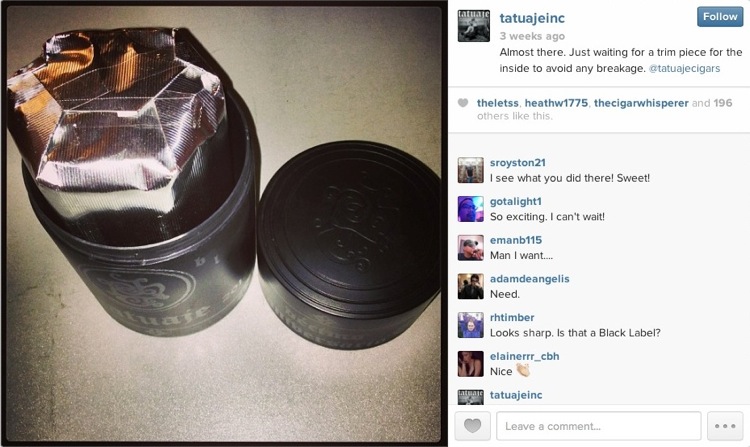
Finally, the cigars are rolled at different factories. The original release was rolled at Tabacalera Cubana S.A., the 2013 release will be rolled at My Father Cigars S.A.
Despite only having one regular production release, the Black Label line has grown immensely since its debut six years ago. To date there have been seventeen different versions of the blend available to the public, four of which have been limited to Johnson’s Saints and Sinners private forum and club. In actuality, with the inclusion of the two release versions for the Black Label Corona Gorda 2013, there will be 23 different releases of the blend with the two Corona Gordas and CRA release all receiving multiple release formats.
The 17 unique vitolas look like this:
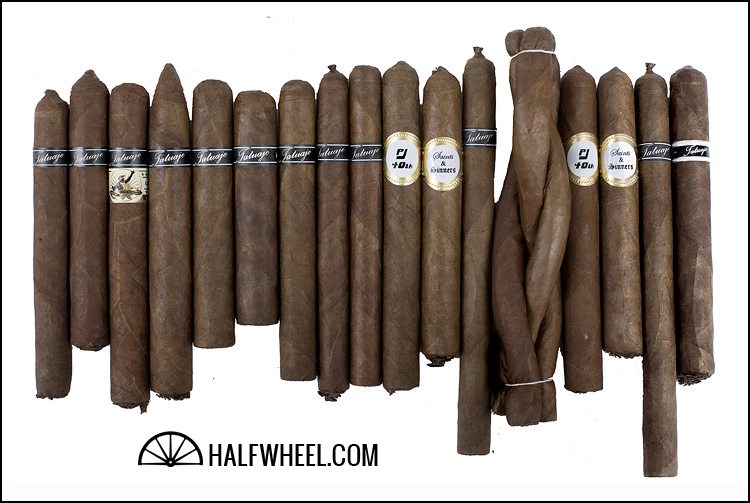
- Tatuaje Black Label Corona Gorda (5 5/8 x 46) — 2007/2008 — Bundles of 24, 25 & 1,000 Jars of 19 Cigars (19,000+ Total Cigars)
- Tatuaje Black Label Robusto (Robusto Three-Pack) (5 x 50) — 2008 — N/A of 3 Cigars (n/a)1
- Tatuaje Black Label Corona Gorda (5 5/8 x 46) — 2007/2008 — Bundles of 24, 25 & 1,000 Jars of 19 Cigars (19,000+ Total Cigars)
- Tatuaje Black Label CRA Toro (6 x 50) — September 2009 — 5,000 Samplers of 1 Cigar (5,000 Total Cigars)2
- Tatuaje Black Label Tubo (6 1/8 x 52) — November 2009 — 4,600 Boxes of 10 Cigars (46,000 Total Cigars)3
- Tatuaje Black Label Robusto (5 x 50) — 2010 — Event Three-Packs (n/a)1
- Tatuaje Black Label Petit Robusto (4 3/8 x 52) — 2010 — Event Three-Packs (n/a)
- Tatuaje Black Label Corona Gorda (5 5/8 x 46) — 2010 — Event Three Packs (n/a)
- Tatuaje Black Label Petite Lancero (Tobacco Grove) (6 x 38) — January 2011 — 200 Boxes of 25 Cigars (5,000 Total Cigars)4
- Tatuaje Black Label Petite Lancero (6 x 38) — July 2011 — Regular Production4
- Tatuaje PJ 40th (S&S 2011) (6 x 46) — July 2011 — 500 Samplers of 1 Cigar (500 Total Cigars)5
- Tatuaje Saints & Sinners Corona Gorda (S&S 2011) — July 2011 — 500 Samplers of 1 Cigar (500 Total Cigars)5
- Tatuaje Black Label Lancero (The Old Man and the C) (7 1/2 x 38) — August 2012 — Limited Production
- Tatuaje Black Label Culebra (The Old Man and the C) (7 1/2 x 38) — August 2012 — Limited Production
- Tatuaje PJ40th (S&S 2012) (6 x 46) — August 2012 — 500 Samplers of 1 Cigar (500 Total Cigars)5
- Tatuaje Saints & Sinners Robusto (S&S 2012) — August 2012 — 500 Samplers of 1 Cigar (500 Total Cigars)5
- Tatuaje Black Label Lancero (New York/New Jersey) (7 1/2 x 38) — December 2012 — 1,000 Boxes of 10 Cigars (10,000 Total Cigars)
- Tatuaje Black Label Corona Gorda 2013 (5 5/8 x 46) — September 2013 — 500 Bundles of 19 Cigars & 10,000 Jars of 19 Cigars (199,500 Total Cigars)
1The original Tatuaje Black Label Robusto featured a closed-foot and nipple cap. The cigar was packaged in a three-pack sampler containing only the Robusto. Subsequent releases were packaged in a three-pack sampler featuring a round head and traditional open foot.
2There were only two shipments of the Tatuaje Black Label CRA Toro, but four samplers. Many cigar manufacturers, including Tatuaje, have shipped the CRA fewer batches than have been samplers.
3There was no exact number of Black Label Tubos released, it was estimated at around 46,000 cigars.
4The Tobacco Grove release of the Petite Lancero featured a closed foot, the regular production version featured an open foot.
5The following cigars have been released as part of the samplers given to the members of Saints and Sinners. They use the Black Label blend.
For those wondering, the three Black Label-banded releases of the Corona Gorda look like this:
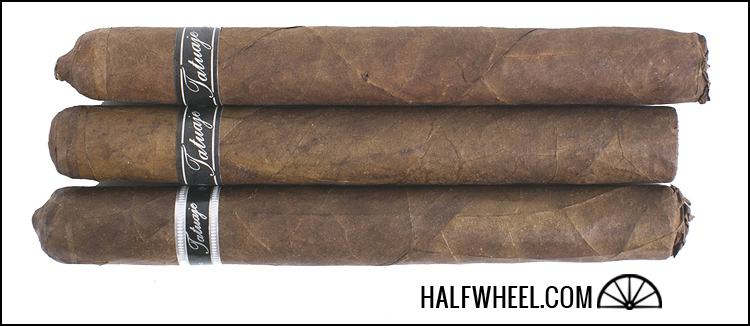
- Original (Bundle/Jar) (2007/2008)
- Event Three-Pack (2010)
- 2013 Jar/Bundle (2013)

- Cigar Reviewed: Tatuaje Black Label Corona Gorda 2013
- Country of Origin: Nicaragua
- Factory: My Father Cigars S.A.
- Wrapper: Nicaraguan Sun Grown Criollo Estelí
- Binder: Nicaragua
- Filler: Nicaragua
- Size: 5 5/8 Inches
- Ring Gauge: 46
- Vitola: Corona Gorda
- MSRP: $10.00 (Bundles/Jars of 19 Cigars, $190.00)
- Release Date: September 2013
- Number of Cigars to be Released: 500 Bundles of 19 Cigars & 10,000 Jars of 19 Cigars (199,500 Total Cigars)
- Number of Cigars Smoked for Review: 2
I was a bit taken back by how pungent the wrapper was after removing the cellophane, it’s definitely not something I remember regarding the Black Label. That being said, the 2013 version does seem rather familiar. There’s a similar color—one that Johnson describes as less than ideal when it comes to being pretty—with a similar rougher feel. Aroma-wise, the pungent leather dominates touches of cocoa, spices and fruit notes. While there is nothing inherently wrong with the new band, I do tend to enjoy the old band better. It is however helpful to being able to tell the difference between the two releases. On both cigars I smoked, the cold draw was open with some pungent leather, sweet sugariness and pepper. It’s shockingly sweet, even if there are two different contrasting notes.
The Tatuaje Black Label begins with a whirlwind flavors. There’s some orange and citrus notes immediately followed by a thick and rougher leather note with a touch of meatiness. Then there’s the finish, which is relatively sweet with the sugar and generic citrus notes mixing, but there’s a touch of sourness that emerges midway through that extends the depth. This level of flavor continues for the remainder of the first third: layered, complex, but with a discernible edginess. It’s at times very challenging to place the profile because of the amount of flavors and the way the hit, which is a good thing in this instance. I actively attempt to slow down, which pays benefits, eventually the leathery core is joined by sweetness and sourness from varying notes of citrus, there’s a bit of cocoa and some harsh cedar rounding out the mouth feel. On the finish through the nose, there’s toasted bread and generic barbecue notes—reminding me of an Australian smoked seasoning I have—it’s quite unique and by far my favorite part of the profile.
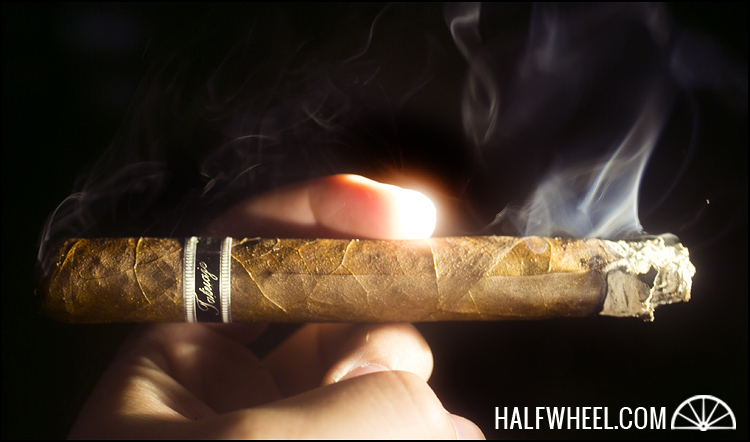
As the second third nears, my only real request would be a tightening of the draw, which was definitely on the open side. It doesn’t really come, and in fact the construction—which was pretty good in the first third—suffers a bit as the smoke noticeably warms. It’s not a big deal, but I imagine it’s not good for the flavor and I honestly don’t think I picked up my smoking rate. There’s a noticeable increase in the toastiness in both the mouth and nose, while a nuttiness begins to challenge the leather notes, albeit unsuccessfully. All three of these notes have an edge, it’s interesting and enjoyable. The cocoa notes have departed, while the pepper increases from the prior third, but now almost entirely on the back of the palate. Smoke is still pouring out of the front of the cigar, while the amount making it into the mouth is somewhere above average.

The burn slows down for the final portion of the new Corona Gorda. It’s now a controlled cigar that sees cigar pour out only when you take a puff. That’s construction, flavor-wise, it’s much the same: complex, layered and with a harshness. I get touches of coffee and a bit of grassiness, but the cigar is really a mixture of the first third and the second third, with the former being more dominant than the latter. Leather is still the core with a familiar woodsiness and cocoa underneath. Both are actually smoother than they were in the prior thirds, but it’s still got some character. I smoke the cigar down as far as I can before the flavor begins departing.

Final Notes
- Let’s get it out of the way to start. Is this better than the original CG? I’m honestly not sure what I am going to tell you that’s going to matter as I don’t have the time machine to go back to 2007 and smoke an original this fresh—and that’s really the only accurate judgment in my mind. What I can tell you is this: both are good cigars with lots of complexity, but given how much has been made of this one cigar online, for some, it’s never realistically going to meet expectations, because no cigar is perfect. I’ll take the Black Label Corona Gorda 2013 fresh over any of the Black Label experiences I’ve had in the last two years, including the original Petite Lancero, Culebra and aged Corona Gorda. It was completely different than the rest of the Black Labels I’ve smoked, and for the better. I imagine it will change dramatically with aging, which honestly, may not be for the better.
- In order for it to be good, you are going to have to shed your distractions. For me, the most important part of the profile is understanding the harsher/rougher notes the cigar possesses. If you smoke this while talking on the phone, watching television and nursing some sort of alcoholic beverage, chances are you going to wonder why the cigar wasn’t as smooth as you’d hope. This was the first third of the first sample I smoked (sans television, phone and alcohol), I just wasn’t in the mindset to really understand the depth of the flavor profile.
- With that is going to come some criticism and a lot of room to interpret the already-subjective activity of “how does a cigar tastes.” If people are honest about it, this will be a divisive flavor profile. Let me be clear, some of you reading this will not like it, and that’s fine. Some of you may not pick up this flavor, that’s also fine. Those that do are going to have to be willing to not simply dismiss the harshness as a defect, but rather, accept it as an added dimension into the overall balance and complexity. The last time I reviewed a cigar like this was the Ezra Zion Tantrum.
- If you aren’t retrohaling, most of the cigars we review will likely taste a lot different than how the staff of halfwheel seems to find them. If you aren’t retrohaling this cigar, it’s one of those times when I would suggest you could be wasting your time. There is plenty of flavor in the mouth, but for the Tatuaje Black Label, the cigar excels in its ability to provide a multitude of sensations, something virtually entirely lost when you don’t retrohale. For a quick primer on retrohaling, check out this video from David “Doc” Diaz.
- If you are wondering what happened to the pictures, we were testing out some new lights and I wasn’t able to make them work. Needless to say, that won’t be happening again.
- I find it interesting that the price of the cigar isn’t affected by the packaging, the bundle versions will carry the same $190.00 MSRP as the jar. It says a lot given how much more expensive the jar is to produce than a normal cedar box.
- While we haven’t seen this particular band before, the style isn’t new. Johnson has used a similar band on the Verocu, and Cojonu 2012s. The bands will definitely help with what would have inevitably been people trying to pass-off newer release versions as the 2007/2008 versions, which oftentimes sell for north of $25.00.
- Brooks, the site’s resident Tatuaje expert, and I differ about how long we will see the jars on shelves at most retailers. While it will largely depend on when and how the cigars get released, I believe we will see them around three months after the final shipment, Brooks tends to think it will be much more. It should be noted, Johnson dramatically staggered the release of the 10,000 box Little Monsters shipment.
- Brooks and I also had a difference of opinion on what the exact name of the cigar would be. Mainly, he believed the “10th anniversary” moniker would find its way into the cigar, as that’s the event that is inspiring the release. I thought it would be avoided as so not to confuse the non-Tatuaje historian as to the release itself, as it isn’t even six years since the original Corona Gorda was released.
- Interestingly, Pete Johnson seemed less interested in the naming of the cigar than the halfwheel editors. He added “2013” to the Black Label Corona Gorda name, which apparently was never really the official name of the first cigar. At the 2007 RTDA show (now known as IPCPR), before the cigar had shipped to retailers, he called it the “Pimp Hammer.” According to Johnson, people would come and say “pimp hammer” and he would give them the cigar. It took on the “Private Reserve” name given it was a blend specifically made for Johnson.
- There is actually a product called the Tatuaje Pimp Hammer. It’s the hammer/box opener tool Johnson began giving out at events some years back.
- I was smoking one of these in a local brick and mortar and the person working the register asked what it was. I then explained, including the fact the cigars were going to be released in jars. The salesperson, who was not in the industry for the original release of the jar, seemed confused as to how the cigars would be effectively sold out of a jar. It’s a valid concern. The consumer can’t see what the cigars look like, curiosity takes over and the end result is inevitably a lot more people picking up the cigars and then dropping them back down in the jars after seeing what it is. Given the size of the release, this wouldn’t have been a huge issue with the first release, inevitably I imagine some cigars are going to have interesting-looking feet when all is said and done.
- Tatuaje is not the first company to release a cigar in a jar, it’s believed H. Upmann first used the jar nearly a century ago. More recent users outside of Cuba have included Ataby, Byron, CAO, Prometheus, Viaje, Zino Platinum.
- This is not only the largest Tatuaje limited edition ever, it’s actually a larger release (199,500 cigars) than the 2011 production of the six core vitolas of Brown Label (174,250 cigars).
- According to my notes from IPCPR 2012, Johnson told us that he and Jaime García were working on a specific project for the 10th anniversary of both El Rey de los Habanos/My Father Cigars and Tatuaje.
- Brooks gets a cinnamon flavor from some of the Black Label vitolas, I’ve never been able to pick it up.
- Please don’t age these, please don’t age these, please don’t age these. I know some are going to stick jars directly into the humidor to never be opened until 2023, that’s fine I suppose. Please smoke a few fresh, at least know what you might be missing out on.
- I would peg strength to be around medium-full, start to finish. By the end there is a decent buzz, but it’s never particularly strong at any given point.
- If I were handicapping the release date of the jars, I would most certainly take the over on Thanksgiving, likely take the over on Christmas and probably say January.
- Final smoking time was an average of an hour and 40 minutes.
- Johnson gave halfwheel samples for this review at IPCPR 2013.
- At over 4,000 words, this is the longest review in halfwheel’s history.
- Site sponsors Atlantic Cigar, Best Cigar Prices, Cigar King, Famous Smoke Shop, Mike’s Cigars, Superior Cigars and Tobacco Grove all carry Tatuaje. I’m not sure who’s getting bundles and who is not, but we will update the review in the comments once they start shipping.
A little more than a year ago, I wrote, "the Black Label blend has been by-in-large disappointing for me, never meeting the immense praise and hoopla associated with the line." I could make the case that all of that is still true, particularly the latter two portions, but I get it now. After smoking the Tatuaje Black Label Corona Gorda 2013, I'm led to believe that the Petite Lancero and Culebra—my two favorite cigars with the black label band to date—aren't actually good representations of the Black Label. If you smoke this cigar distracted, you won't get it. The beauty of the Black Label blend is this discerning roughness that multiplies the complexity of the blend immensely. If you wrote down the flavors, sans this edginess, and gave it to me, I would tell you that you were probably smoking a Cuban cigar, which I suppose is a victory for Johnson. But, it couldn't be any further from the truth. The most recent version of the Black Label blend has a refined harshness that is the answer I was looking for ever since my first Black Label, and that's why once these start hitting shelves, I'll smoke them fresh—presumably like they were intended to be enjoyed. I've had my fair share of the originals, the older event releases and more, they are not bad cigars by any means, but they are far cry from what I smoked fresh. Hoopla, sentiments, celebration, relief aside—this is a great cigar, for an advanced and open-minded palate, let's try not to ruin it.

